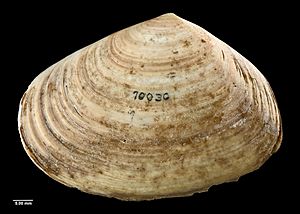Paphies facts for kids
Quick facts for kids Paphies |
|
|---|---|
 |
|
| Paphies donacina (Spengler, 1793) | |
| Scientific classification |
|
| Kingdom: | Animalia |
| Phylum: | Mollusca |
| Class: | Bivalvia |
| Subclass: | Heterodonta |
| Order: | Venerida |
| Superfamily: | Mactroidea |
| Family: | Mesodesmatidae |
| Genus: | Paphies Lesson, 1830 |
| Species | |
|
See text. |
|
Paphies are a group of large, tasty saltwater clams. They are a type of bivalve mollusc, which means they have two shells that hinge together. These clams belong to the family called Mesodesmatidae. You can only find Paphies clams in New Zealand; they are endemic there. Some well-known types of Paphies include the pipi (P. australis), tuatua (P. subtriangulata), and toheroa (P. ventricosa).
Contents
What are Paphies Clams?
Paphies clams are marine animals that live in the ocean. They are called "bivalves" because their bodies are protected by two strong shells. These shells are connected by a hinge, allowing the clam to open and close. Clams are invertebrates, meaning they do not have a backbone.
They live buried in the sand on beaches or in estuaries. An estuary is where a river meets the sea. They use a strong foot to dig into the sand. This helps them stay safe from predators and strong waves.
Types of Paphies Clams
There are several different types of Paphies clams. Each type has its own special features. Here are some of the main species:
Pipi (Paphies australis)
The pipi is a very common Paphies clam. You can often find them in sandy or muddy areas of estuaries. They are usually smaller than other Paphies species. Pipi are popular for eating in New Zealand.
Tuatua (Paphies subtriangulata)
Tuatua clams live on sandy beaches. They are often found closer to the open ocean than pipi. Tuatua have a more triangular shape compared to pipi. Like pipi, they are also a popular food source.
Toheroa (Paphies ventricosa)
The toheroa is a much larger Paphies clam. It is known for its delicious taste. Toheroa live on specific sandy beaches, often in areas with strong waves. Because they are so popular, there are strict rules about collecting them. This helps protect their numbers.
Other Paphies Species
Another species is Paphies donacina. This clam also lives in marine environments. All these species are important parts of New Zealand's coastal ecosystems.
Where Paphies Clams Live
Paphies clams are found only in the waters around New Zealand. This means they are endemic to this country. They live in different coastal habitats. Some prefer sheltered estuaries, while others live on open sandy beaches.
They bury themselves in the sand or mud. They use two tubes called siphons. One siphon takes in water, bringing in food and oxygen. The other siphon pushes out waste water. This way, they can feed and breathe while staying hidden.
Paphies Clams and People
For many years, Paphies clams have been an important food source. The Māori people of New Zealand have traditionally gathered these clams. They are a valuable part of the local diet.
Today, people still enjoy eating Paphies clams. They can be cooked in many ways, like steaming or frying. Because they are so popular, it is important to collect them responsibly. This helps make sure there are enough clams for the future. Rules and limits are often in place to protect clam populations.
Images for kids


